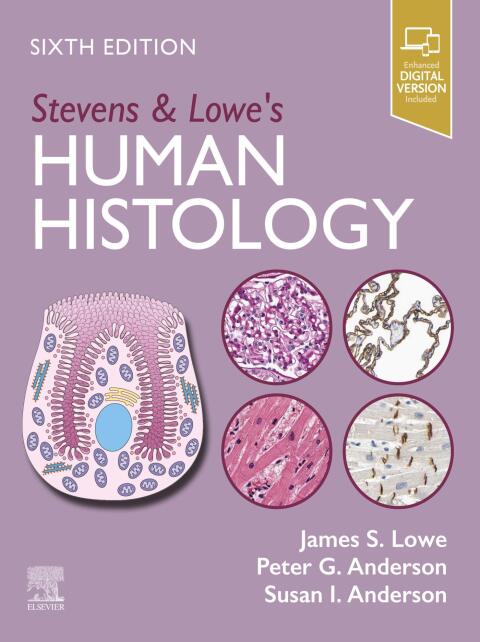Description
Efnisyfirlit
- Instructions for online access
- Cover image
- Title page
- Table of Contents
- Copyright
- Dedication
- Preface to the sixth edition
- Acknowledgements to the sixth edition
- Human Histology online videos
- List of Illustrations
- List of Tables
- 1. Histology
- Introduction
- Cells are basic functional units
- Techniques used in histology and cell biology
- Electron microscopy
- Confocal microscopy
- Virtual microscopy
- 2. The cell
- Introduction
- Cell membranes
- Transport in and out of cells
- Cytosol
- The nucleus
- Mitochondria
- Endoplasmic reticulum and Golgi
- Vesicles
- Cytoskeleton
- Cell inclusions and storage products
- Cell division
- Cell death
- 3. Epithelial cells
- Introduction
- Epithelial cell junctions
- Epithelial cell surface specializations
- Secretory adaptations
- Barrier function of epithelium
- 4. Support cells and the extracellular matrix
- Introduction
- Extracellular matrix
- Basement membrane and external lamina
- Cell adhesion to extracellular matrix
- Support cell family
- 5. Contractile cells
- Introduction
- Skeletal muscle
- Cardiac muscle
- Smooth muscle
- Myofibroblasts
- Pericytes
- Myoepithelial cells
- 6. Nervous tissue
- Introduction
- Nerve cells (neurons)
- Myelin
- Central nervous system
- Peripheral nervous system
- 7. Blood cells
- Introduction
- Bone marrow–derived stem cells
- Methods of studying the blood cells
- Red blood cells
- White blood cells
- Platelets
- Haematopoiesis
- Bone marrow
- 8. Immune system
- Introduction
- Lymphocytes
- Macrophages and dendritic cells
- Bone marrow
- Thymus
- Lymph nodes
- Spleen
- Mucosa-associated lymphoid tissue
- 9. Blood and lymphatic circulatory systems and heart
- Introduction
- Blood circulatory system
- Systemic blood vessels
- Portal blood systems
- Lymphatic circulatory system
- Stem cells and the vasculature
- The heart
- Stem cells and the heart
- 10. Respiratory system
- Introduction
- Pulmonary vasculature
- Pleura
- 11. Alimentary tract
- Introduction
- Oral cavity and its contents
- Teeth
- The gums
- Salivary glands
- Transport passages
- Oesophagus
- Anal canal
- Digestive tract
- Stomach
- Small intestine
- Exocrine pancreas
- Large intestine
- Appendix
- 12. Liver
- Introduction
- Liver vasculature
- Hepatocytes
- Functional organization of hepatocytes
- Intrahepatic biliary tree
- Gallbladder
- 13. Musculoskeletal system
- Introduction
- Skeletal muscle
- Muscle attachments
- Bone
- Bone cells
- Mineralization of osteoid
- Bone remodelling
- Joints
- 14. Endocrine system
- Introduction
- Endocrine cell and tissue specialization
- Pituitary
- Anterior pituitary
- Posterior pituitary
- Hypothalamus
- Pineal gland
- Thyroid gland
- Parathyroid
- Adrenals
- Pancreas
- Ovary and testis
- Diffuse neuroendocrine system
- Paraganglia
- 15. Urinary system
- Introduction
- Kidney structure
- Kidney function
- Kidney vasculature
- Renal microcirculation
- Nephron
- Glomerulus
- Glomerular filtration barrier
- Mesangium
- Tubular and collecting system
- Renal interstitium
- Juxtaglomerular apparatus
- Erythropoietin synthesis
- Lymphatic drainage and nerve supply of the kidney
- Lower urinary tract
- 16. Male reproductive system
- Introduction
- Testes
- Epididymis
- Vas deferens
- Seminal vesicles
- Prostate
- Bulbourethral glands
- Penis
- Endocrine control
- 17. Female reproductive system
- Introduction
- Mons pubis, labia majora and labia minora
- Clitoris
- Vagina
- Uterus
- Ovary
- Menstrual cycle
- Pregnancy
- Trophoblast and placenta
- 18. Skin and breast
- Introduction
- Epidermis
- Skin appendages
- Dermis
- Subcutaneous tissue
- Features of skin in different sites
- Breast
- 19. Special senses
- Introduction
- Ear
- Eye
- Accessory components of the eye
- Case studies
- Review questions
- Review answers
- Index







Reviews
There are no reviews yet.